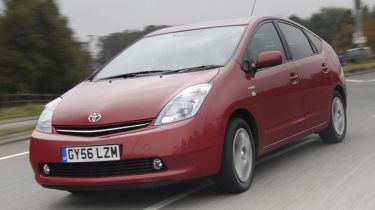Toyota Prius T3
It’s set the standard for hybrid vehicles, and the Prius aims to clean up against the most economical diesels.
The impact of the Toyota Prius goes much further than the fact that it’s the world’s most successful hybrid vehicle. Three-quarters-of-a-million have been sold, but the role it has played in raising the profile of low-emission vehicles on the global stage is arguably of equal importance. It’s proof that car firms are becoming more green conscious.
And make no mistake, this Toyota is futuristic. Not only in the way it looks – both inside and out – but the technology under the skin. While it’s quite complex, the basics of the system are as follows. The Prius is powered by two sources: a 1.5-litre engine and an electric motor. Both have their own fuel supplies – petrol tank and battery respectively.
What’s clever, though, is that the battery is topped up from the engine or by kinetic energy when slowing down, so it never needs to be recharged externally – unlike a pure electric vehicle. Toyota also offers an eight-year warranty on the hardware, and none of it requires any maintenance, which helps keep service costs down.
While it isn’t the cheapest car to buy, in practice the Prius works brilliantly. Unless you keep a close eye on the charts and displays on the dash, it’s virtually impossible to tell where and how the power is being delivered. That’s not to say you can’t influence the system, though. There’s a gearbox mode that increases engine braking to replenish the battery charge more quickly, plus an EV button which allows you to run exclusively on electric power.
The 1,325kg Toyota is only capable of moving about a mile on electricity alone. But on our urban route, that – combined with the fact the petrol unit cuts off when the car is stationary – saw the Prius achieve 41.0mpg. A decent return, although not a match for the excellent MINI.
So it’s clear the Prius makes most sense when driving around town. But once speeds increased, the car’s drawbacks quickly become clear – it’s heavy and runs on petrol, while the CVT gearbox uses higher revs than necessary if you’re trying to save fuel.
In theory, on the motorway the Toyota should perform well.It has superb aerodynamics, at 0.26 Cd, and steadier speeds should suit the drivetrain. Yet it averaged 53.3mpg, which is worse than all but the Clio.
What’s more, the sensitivity of the transmission means driving style influences economy to a large degree. Up the pace slightly, and consumption rises sharply compared to the oil-burners.
So although the Prius is the original and best hybrid, it can’t match the efficiency and low running costs of the top diesels.
Details
Price: £17,777
Model tested: Toyota Prius T3
Chart position: 5
WHY: Hybrids such as the Prius claim incredible efficiency. We see if the car can live up to its promise.
Economy
Urban: 41.0mpg Cross-country: 59.7mpg Motorway: 53.3mpg Combined: 54.3mpg







